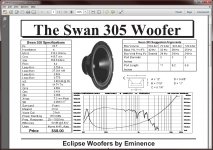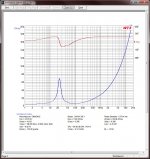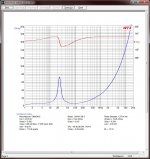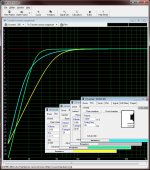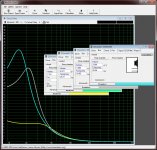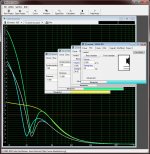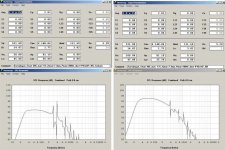I have 4 Eminence Swan 305 12” woofers that have served as the bass section of my shop speakers for 20 some years. The original boxes I built for them are simple sealed enclosures based on the original spec sheet of the Swan driver when I bought them from Madisound. They sound ok for what they are.
I have been working on a design that utilizes these drivers to their full potential. With more experience and better design tools, I think a ported design would be better and to save space I feel an isobaric ported design shows promise. I have been working on this off and on for a year or 2. After reading some of the recent threads on this subject I would like to get some input on this model. There are a couple of issues that I still have to work out. I will get to those shortly. This post is a sanity check to make sure I haven’t stepped of the path. If any of you have suggestions or comments that is what I am fishing for.
This design is not really a subwoofer design (although if I built the bass cab as a single unit it could be) but more the bass section of a 3-way or a 2 way that utilizes a 3- 4” full range as a mid-tweeter. I have a couple of Fostex 126En drivers that ran that duty for a while in the original cabinet with the Swan. I also have some Focal 120 tweeters lying around if I choose to go 3-way. I think these woofers should be okay up to about 400 Hz if needed but I have not gotten that far in the design. This post is primarily about the bass cabinet or cabinet section.
I measured the drivers and compared the specs against the original spec sheet. They have many hours on them (almost every weekend and some weeknights for 20 years) so I would consider them “broken in”. They measure relatively close to the spec sheet with the exception of the Vas. The difference in Vas may be suspect as I did not measure it with added mass. I took the measurements with a Dayton Woofer tester. The only option I had for the Vas measurement was the “SPL method”. Not sure if this is reliable (anyone who has experience feel free to chime in on this). The other issue is that the drivers are listed as 8 ohms nominal. Their actual ohm load is closer to 5.5. Parallel wiring in isobaric configuration I feel is too low an amp load for most home amplifiers. Series wiring would yield around 11.5 ohms which although high, I feel is acceptable.
I ran the models in WINisd Pro. If I run the spec sheet I get a ported box of 5 cu ft. for a single woofer and if I run the measured specs I get a box of 6 cu ft. I went with the measured specs. With the exception of box size, the curves for the spec sheet and the measured specs are very close. This box is too large for my application. If I go to an isobaric alignment, it nets half the volume and brings it down to 3 cu ft. (which I can work with) with an f3 of about 24hz (if that is realistic). In an isobaric configuration I still have to compensate the internal volume for the second woofer tunnel, the second woofer and the port tube and tube volume. This will still make a big box bigger but it won’t be the 6 cu ft. of the single woofer box. It is about 3.5 cubic feet.
I like the idea of rounding off the “knee” to get cleaner bass by tuning the box to a lower frequency as I have read in previous threads. In this case it is 20 Hz. The light blue model curve reflects this. I have included the group delay and excursion graphs for each alignment. The single driver alignments are at signal strength of 100 watts and the isobaric are 200 watts. The other curves are sealed single and ported for lowest f3.
The only real issue I am having is port length. I calculated the minimum port diameter at 3.5 in. at 3.5 in the port is 19” long. Would a port this long lead to possible port resonances? I can get it in the box. That is not a problem. It just seems long. If I go to a 3.03 port it will bring the length down to about 12in. but with that port the diameter is too small and will possibly create noise.
I have been working on a design that utilizes these drivers to their full potential. With more experience and better design tools, I think a ported design would be better and to save space I feel an isobaric ported design shows promise. I have been working on this off and on for a year or 2. After reading some of the recent threads on this subject I would like to get some input on this model. There are a couple of issues that I still have to work out. I will get to those shortly. This post is a sanity check to make sure I haven’t stepped of the path. If any of you have suggestions or comments that is what I am fishing for.
This design is not really a subwoofer design (although if I built the bass cab as a single unit it could be) but more the bass section of a 3-way or a 2 way that utilizes a 3- 4” full range as a mid-tweeter. I have a couple of Fostex 126En drivers that ran that duty for a while in the original cabinet with the Swan. I also have some Focal 120 tweeters lying around if I choose to go 3-way. I think these woofers should be okay up to about 400 Hz if needed but I have not gotten that far in the design. This post is primarily about the bass cabinet or cabinet section.
I measured the drivers and compared the specs against the original spec sheet. They have many hours on them (almost every weekend and some weeknights for 20 years) so I would consider them “broken in”. They measure relatively close to the spec sheet with the exception of the Vas. The difference in Vas may be suspect as I did not measure it with added mass. I took the measurements with a Dayton Woofer tester. The only option I had for the Vas measurement was the “SPL method”. Not sure if this is reliable (anyone who has experience feel free to chime in on this). The other issue is that the drivers are listed as 8 ohms nominal. Their actual ohm load is closer to 5.5. Parallel wiring in isobaric configuration I feel is too low an amp load for most home amplifiers. Series wiring would yield around 11.5 ohms which although high, I feel is acceptable.
I ran the models in WINisd Pro. If I run the spec sheet I get a ported box of 5 cu ft. for a single woofer and if I run the measured specs I get a box of 6 cu ft. I went with the measured specs. With the exception of box size, the curves for the spec sheet and the measured specs are very close. This box is too large for my application. If I go to an isobaric alignment, it nets half the volume and brings it down to 3 cu ft. (which I can work with) with an f3 of about 24hz (if that is realistic). In an isobaric configuration I still have to compensate the internal volume for the second woofer tunnel, the second woofer and the port tube and tube volume. This will still make a big box bigger but it won’t be the 6 cu ft. of the single woofer box. It is about 3.5 cubic feet.
I like the idea of rounding off the “knee” to get cleaner bass by tuning the box to a lower frequency as I have read in previous threads. In this case it is 20 Hz. The light blue model curve reflects this. I have included the group delay and excursion graphs for each alignment. The single driver alignments are at signal strength of 100 watts and the isobaric are 200 watts. The other curves are sealed single and ported for lowest f3.
The only real issue I am having is port length. I calculated the minimum port diameter at 3.5 in. at 3.5 in the port is 19” long. Would a port this long lead to possible port resonances? I can get it in the box. That is not a problem. It just seems long. If I go to a 3.03 port it will bring the length down to about 12in. but with that port the diameter is too small and will possibly create noise.
Attachments
- Status
- Not open for further replies.
